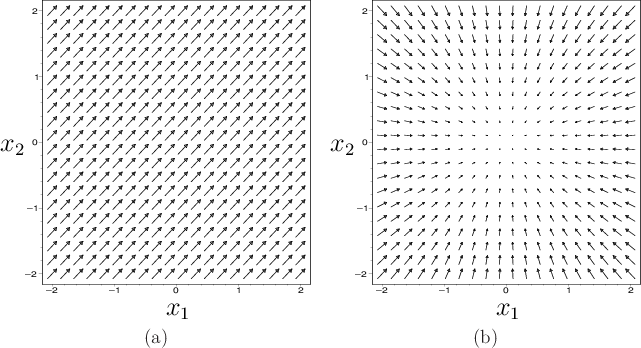
Next: Smoothness Up: 8.3.1 Vector Fields on Previous: Vector spaces
A vector field looks like a ``needle diagram'' over
![]() , as
depicted in Figure 8.5. The idea is to specify a
direction at each point
, as
depicted in Figure 8.5. The idea is to specify a
direction at each point
![]() . When used to represent a
feedback plan, it indicates the direction that the robot needs to move
if it finds itself at
. When used to represent a
feedback plan, it indicates the direction that the robot needs to move
if it finds itself at ![]() .
.
For every
![]() , associate an
, associate an ![]() -dimensional vector space
called the tangent space at
-dimensional vector space
called the tangent space at ![]() , which is denoted as
, which is denoted as
![]() . Why not just call it a vector space at
. Why not just call it a vector space at ![]() ? The use of
the word ``tangent'' here might seem odd; it is motivated by the
generalization to manifolds, for which the tangent spaces will be
``tangent'' to points on the manifold.
? The use of
the word ``tangent'' here might seem odd; it is motivated by the
generalization to manifolds, for which the tangent spaces will be
``tangent'' to points on the manifold.
A vector field8.4 ![]() on
on
![]() is a function that
assigns a vector
is a function that
assigns a vector
![]() to every
to every
![]() . What is
the range of this function? The vector
. What is
the range of this function? The vector
![]() at each
at each
![]() actually belongs to a different tangent space. The range of the
function is therefore the union
actually belongs to a different tangent space. The range of the
function is therefore the union
A vector field can therefore be expressed using ![]() real-valued
functions on
real-valued
functions on
![]() . Let
. Let
![]() for
for ![]() from
from ![]() to
to
![]() denote such functions. Using these, a vector field is specified
as
denote such functions. Using these, a vector field is specified
as
Now consider some examples of vector fields over
![]() . Let a point
in
. Let a point
in
![]() be represented as
be represented as ![]() . In standard vector
calculus, a vector field is often specified as
. In standard vector
calculus, a vector field is often specified as
![]() , in which
, in which ![]() and
and ![]() are functions on
are functions on
![]()
 |
Due to obstacles that arise in planning problems, it will be
convenient to sometimes restrict the domain of a vector field to an
open subset of
![]() . Thus, for any open subset
. Thus, for any open subset
![]() ,
a vector field
,
a vector field
![]() can be defined.
can be defined.
Steven M LaValle 2020-08-14